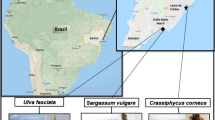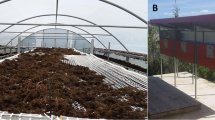Abstract
Seaweeds are an ideal food-safe natural source of minerals with a potential use in human nutrition. However, the presence of phytate and different treatments before consumption could modify mineral availability. The content and in vitro mineral availability after a simulated gastrointestinal digestion of wakame (Undaria pinnatifida), nori (Porphyra spp.), sea salad (Ulva lactuca, Palmaria palmata, Undaria pinnatifida, Porphyra spp., Laminaria spp.), and sea spaghetti (Himanthalia elongata) were studied. Experiments were assessed after a soaking treatment of seaweeds with cold (20 °C) or hot (70 °C) water, as usually processing before eating. Moreover, inositol phosphate content was determined in the edible macroalgae and the molar ratio phytate/mineral was used as a predictor of the relative availability of minerals. Overall, edible analyzed seaweeds showed a high Ca, Fe, P, and K contents, highlighting wakame for all the studied minerals. In all cases, soaking in cold water showed the highest soluble and dialyzable mineral fractions. High content of phytic acid (IP6) was observed in sea salad (≈ 25 mg (100 g)−1); meanwhile, sea spaghetti showed the lowest IP6 content (3.9 mg (100 g)−1). The low molar ratios Phy/Ca and Phy/Zn obtained in seaweeds could indicate an adequate availability. However, ratios Phy/Fe could compromise the iron availability in wakame, nori, and sea spaghetti. Results obtained confirm that external factor such as soaking, gastrointestinal digestion, and inositol phosphates can affect the mineral availability. Consumption of edible seaweeds can be recommended for the necessary intake of available minerals and trace elements.
Similar content being viewed by others
References
Astorga-Espana MS, Galdon BR, Rodriguez EMR, Romero CD (2015) Mineral and trace element concentrations in seaweeds from the sub-Antarctic ecoregion of Magallanes (Chile). J Food Compos Anal 39:69–76
Besada V, Andrade JM, Schultze F, González JJ (2009) Heavy metals in edible seaweeds commercialised for human consumption. J Mar Syst 75:305–313
Boato F, Wortley GM, Liu RH, Glahn RP (2002) Red grape juice inhibits iron availability: application of an in vitro digestion/caco-2 cell model. J Agric Food Chem 50:6935–6938
Brown KH, Rivera JA, Bhutta Z, Gibson RS, King JC, Lonnerdal B, Ruel MT, Sandtrom B, Wasantwisut E, Hotz C, International Zinc Nutrition Consultative G (2004) International Zinc Nutrition Consultative Group (IZiNCG) technical document #1. Assessment of the risk of zinc deficiency in populations and options for its control. Food Nutr Bull 25(1 Suppl 2):S99–S203
Cabrita ARJ, Maia MRG, Oliveira HM, Sousa-Pinto I, Almeida AA, Pinto E, Fonseca AJM (2016) Tracing seaweeds as mineral sources for farm-animals. J Appl Phycol 28:3135–3150
Chapman VJ (1980) Sea vegetables (algae as food for man). In: Chapman VJ (ed) Seaweeds and their uses. Springer, Dordrecht, pp 334–344
Cian RE, Fajardo MA, Alaiz M, Vioque J, González RJ, Drago SR (2014) Chemical composition, nutritional and antioxidant properties of the red edible seaweed Porphyra columbina. Int J Food Sci Nutr 65(3):299–305
Cofrades S, Lopez-Lopez I, Bravo L, Ruiz-Capillas C, Bastida S, Larrea MT, Jimenez-Colmenero F (2010) Nutritional and antioxidant properties of different brown and red Spanish edible seaweeds. Food Sci Technol Int 16:361–370
Dawczynski C, Schaefer U, Leiterer M, Jahreis G (2007) Nutritional and toxicological importance of macro, trace, and ultra-trace elements in algae food products. J Agric Food Chem 55:10470–10475
EPA (1994) Microwave assisted acid digestion of sediments, sludges, soils, and oils. Method 3051A
European Food Safety Authority (EFSA) (2017) Dietary reference values for nutrients: Summary report. EFSA Supporting Publication 2017:e15121. 92 pp. https://doi.org/10.2903/sp.efsa.2017.e15121
Frontela C, Garcia-Alonso FJ, Ros G, Martinez C (2008) Phytic acid and inositol phosphates in raw flours and infant cereals: the effect of processing. J Food Compos Anal 21:343–350
Frontela C, Ros G, Martinez C (2011) Phytic acid content and “in vitro” iron, calcium and zinc bioavailability in bakery products: the effect of processing. J Cereal Sci 54:173–179
García-Casal MN, Pereira AC, Leets I, Ramìrez J, Quiroga MF (2007) High iron content and bioavailability in humans from four species of marine algae. J Nutr 137:2691–2695
Garcia-Sartal C, Barciela-Alonso MD, Moreda-Pineiro A, Bermejo-Barrera P (2013) Study of cooking on the bioavailability of As, Co, Cr, Cu, Fe, Ni, Se and Zn from edible seaweed. Microchem J 108:92–99
Hotz C, Gibson RS (2001) Assessment of home-based processing methods to reduce the phytate content and phytate/zinc molar ratio of white maize (Zea mays). J Agric Food Chem 49:692–698
Hurrell RF (2004) Phytic acid degradation as a means of improving iron absorption. Int J Vitam Nutr Res 74(6):445–452
Jensen A (1993) Present and future-needs for algae and algal products. Hydrobiologia 261:15–23
Kapsokefalou M, Kakouris V, Makris K, Galiotou-Panayotou M, Komaitis M (2007) Oxidative activity and dialyzability of some iron compounds under conditions of a simulated gastrointestinal digestion in the presence of phytate. Food Chem 101:419–427
Kruger J, Oelofse A, Taylor JR (2014) Effects of aqueous soaking on the phytate and mineral contents and phytate:mineral ratios of wholegrain normal sorghum and maize and low phytate sorghum. Int J Food Sci Nutr 65(5):539–546
Liang J, Han B-Z, Nout MJR, Hamer RJ (2008) Effects of soaking, germination and fermentation on phytic acid, total and in vitro soluble zinc in brown rice. Food Chem 110:821–828
Lönnerdal B (2010) Calcium and iron absorption - mechanisms and public health relevance. Int J Vitam Nutr Res 80:293–299
Mabeau S, Fleurence J (1993) Seaweed in food-products - biochemical and nutritional aspects. Trends Food Sci Technol 4:103–107
MacArtain P, Gill CIR, Brooks M, Campbell R, Rowland IR (2007) Nutritional value of edible seaweeds. Nutr Rev 65:535–543
Martinez-Hernandez GB, Castillejo N, Carrion-Monteagudo MM, Artes F, Artes-Hernandez F (2018) Nutritional and bioactive compounds of commercialized algae powders used as food supplements. Food Sci Technol Int 24:172–182
McCance RAWEHB (1993) McCance and Widdowson’s composition of foods: summary edition, 6th edn. Royal Society of Chemistry, Cambridge
Mendis E, Kim S-K (2011) Present and future prospects of seaweeds in developing functional foods. Adv Food Nutr Res 64:1–15
Mohamed S, Hashim SN, Rahman HA (2012) Seaweeds: a sustainable functional food for complementary and alternative therapy. Trends Food Sci Technol 23:83–96
Nisizawa K, Noda H, Kikuchi R, Watanabe T (1987) The main seaweed foods in Japan. Hydrobiologia 151:5–29
Odell BL (1984) Bioavailability of trace-elements. Nutr Rev 42:301–308
Oliveira M, Freitas A, Carvalho A, Sampaio T, Farias D, Teixeira D, Gouveia S, Pereira J, Sena M (2009) Nutritive and non-nutritive attributes of washed-up seaweeds from the coast of Ceara?, Brazil. Food Chem 115:254–259
Ortega-Calvo JJ, Mazuelos C, Hermosin B, Saizjimenez C (1993) Chemical-composition of Spirulina and eukaryotic algae food-products marketed in Spain. J Appl Phycol 5:425–435
Perez V, Chang ET (2014) Sodium-to-potassium ratio and blood pressure, hypertension, and related factors. Adv Nut 5:712–741
Phytonutrition. Id (2004) Functional, health and therapeutic effects of algae and seaweed. Institut de Phytonutrition, Beausoleil
Rajapakse N, Kim S-K (2011) Nutritional and digestive health benefits of seaweed. Adv Food Nutr Res 64:17–28
Rao PVS, Mantri VA, Ganesan K (2007) Mineral composition of edible seaweed Porphyra vietnamensis. Food Chem 102:215–218
Rubio C, Napoleone G, Luis-González G, Gutiérrez AJ, González-Weller D, Hardisson A, Revert C (2017) Metals in edible seaweed. Chemosphere 173:572–579
Ruperez P (2002) Mineral content of edible marine seaweeds. Food Chem 79:23–26
Sandberg AS, Brune M, Carlsson NG, Hallberg L, Skoglund E, Rossander-Hulthen L (1999) Inositol phosphates with different numbers of phosphate groups influence iron absorption in humans. Am J Clin Nutr 70:240–246
Santoso J, Gunji S, Yoshie-Stark Y, Suzuki T (2006) Mineral contents of Indonesian seaweeds and mineral solubility affected by basic cooking. Food Sci Technol Res 12:59–66
Tabarsa M, Rezaei M, Ramezanpour Z, Waaland JR (2012) Chemical compositions of the marine algae Gracilaria salicornia (Rhodophyta) and Ulva lactuca (Chlorophyta) as a potential food source. J Sci Food Agric 92:2500–2506
Taboada C, Millan R, Miguez I (2010) Composition, nutritional aspects and effect on serum parameters of marine algae Ulva rigida. J Sci Food Agric 90:445–449
Umeta M, West CE, Fufa H (2005) Content of zinc, iron, calcium and their absorption inhibitors in foods commonly consumed in Ethiopia. J Food Compos Anal 18:803–817
Wells ML, Potin P, Craigie JS, Raven JA, Merchant SS, Helliwell KE, Smith AG, Camire ME, Brawley SH (2017) Algae as nutritional and functional food sources: revisiting our understanding. J Appl Phycol 29:949–982
World Health Organization (2012) Guideline: sodium intake for adults and children. World Health Organization, Geneva
Yang Q, Liu T, Kuklina EV, Flanders WD, Hong Y, Gillespie C, Chang MH, Gwinn M, Dowling N, Khoury MJ, Hu FB (2011) Sodium and potassium intake and mortality among US adults: prospective data from the Third National Health and Nutrition Examination Survey. Arch Intern Med 171(13):1183–1191
Yoshie Y, Suzuki T, Pandolf T, Clydesdale FM (1999) Solubility of iron and zinc in selected seafoods under simulated gastrointestinal conditions. Food Sci Technol Res 5:140–144
Zheng FY, Chen LH, Li SX, Qiu YQ (2013) Effect of edible plants combination on mineral bioaccessibility and bioavailability, using in vitro digestion and liposome-affinity extraction. Food Res Int 53:174–179
Funding
We would like to thank to Ministerio de Educación, Cultura y Deporte (Spain), because of the economic opportunity of the PhD grant given to Teresa Sánchez-Moya (FPU 13/02380).
Author information
Authors and Affiliations
Corresponding author
Ethics declarations
Competing interests
The authors declare that they have no competing interests.
Rights and permissions
About this article
Cite this article
Sánchez-Moya, T., Martínez-Hernández, V.M., López-Nicolás, R. et al. Effect of soaking and inositol phosphate content on in vitro mineral availability in edible seaweeds. J Appl Phycol 31, 1981–1989 (2019). https://doi.org/10.1007/s10811-018-1677-x
Received:
Revised:
Accepted:
Published:
Issue Date:
DOI: https://doi.org/10.1007/s10811-018-1677-x




